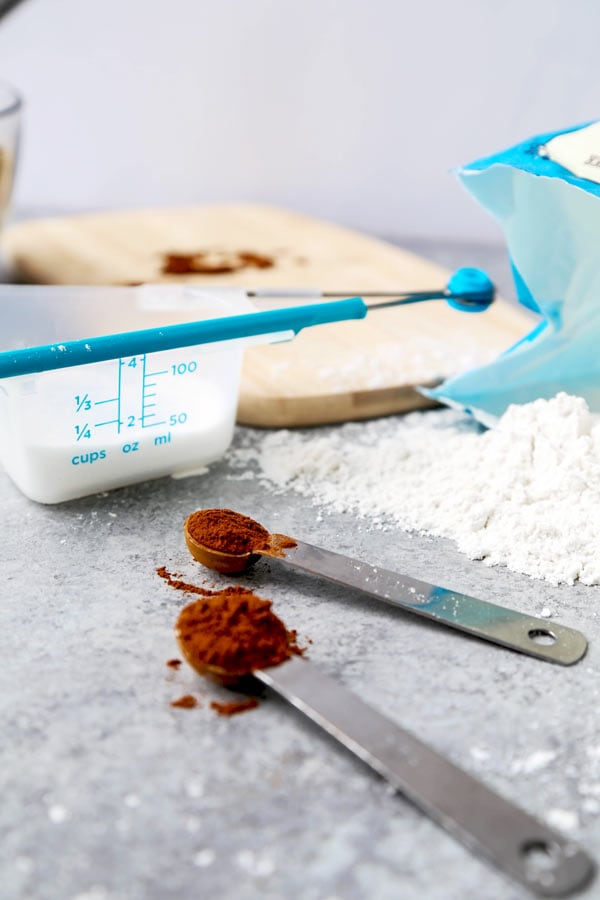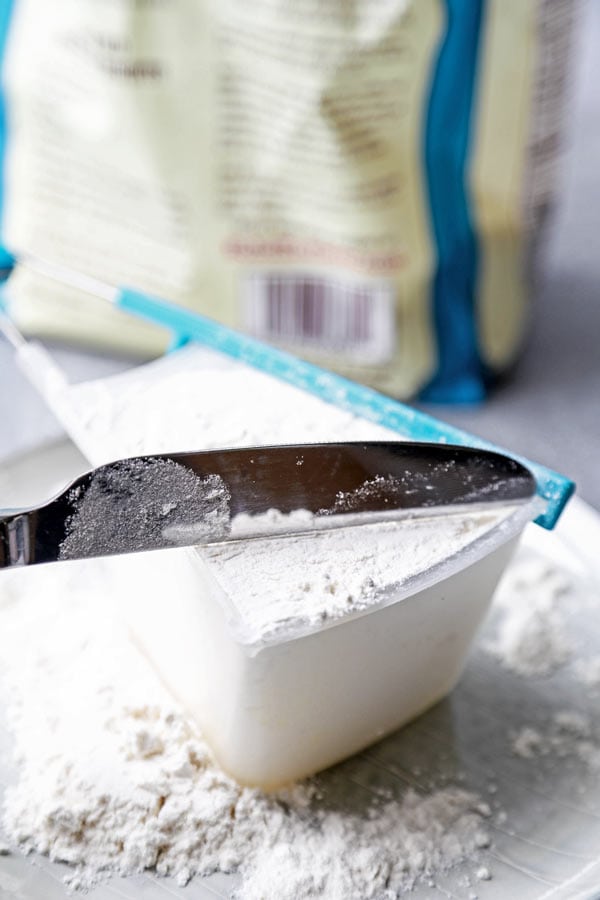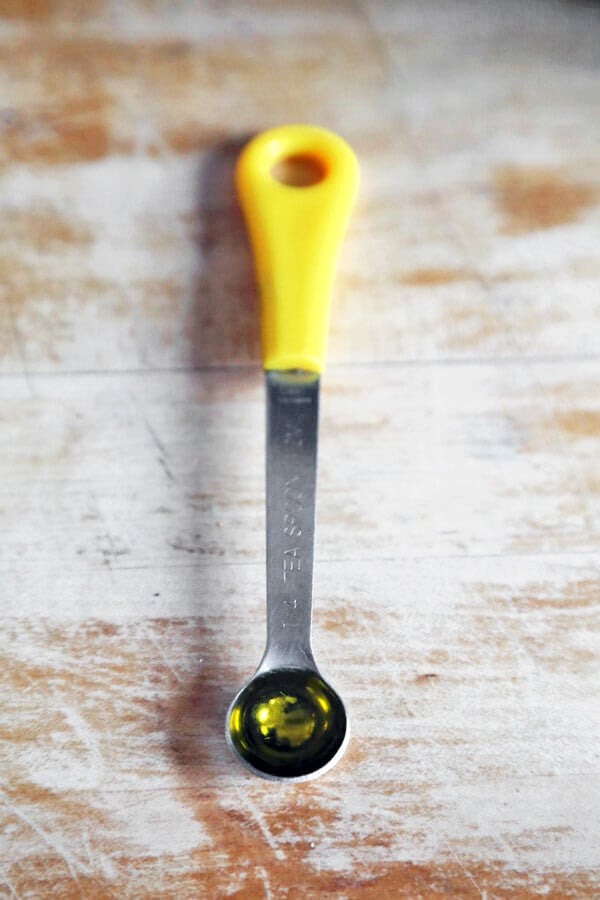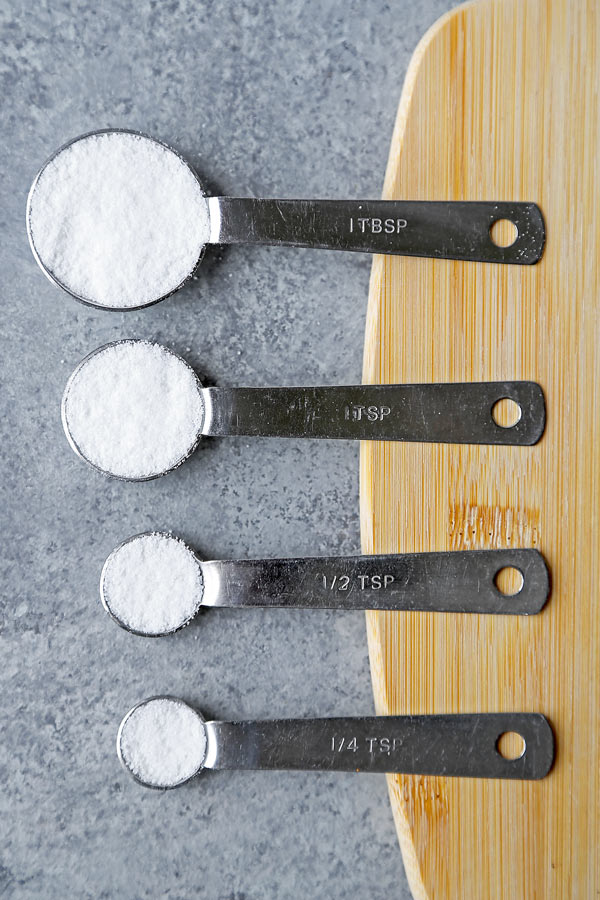American standard conversion charts for both dry and liquid measurements.

US Standard Cooking Measurements
Cooking conversions can be difficult to understand if you have to do the math without the help of a digital food scale. This can become frustrating, especially if you are in the middle of baking since the weight of dry ingredients such as sugar and flour can be quite different when converted from cups to grams.
To give you an example:
- 1 cup of confectioner’s sugar = 113 grams
- 1 cup of packed brown sugar = 207 grams
- 1 cup of all-purpose flour is = 120 grams
This can seriously affect how your cookies and pastries come out. Add too much or not enough of one thing and you can end up with flat or dense baked goods. Accurate measuring is important to the success of each recipe but when it comes to baking, it’s critical.
Here is a quick guide to measuring common ingredients. I’ve also added conversion charts for both dry and liquid measurements.
Ultimately, having a digital food scale is by far the easiest way to do cooking conversions. It will also save you time and guarantee that your food will come out good every time.
The Correct Way To Measure Dry Ingredients


Flour
To measure flour correctly, you must scoop it straight from the bag or container you store it in. Do not use a measuring cup and instead, use a large spoon to lightly scoop the flour into the measuring cup.
Don’t pack the flour, just spoon it into the measuring cup and leave it there without shaking. Then using the back of a knife or a flat spatula, run along the top edge of the measuring cup to remove excess flour.
You can use the same steps for tablespoon and teaspoon measurements.

Brown Sugar
Brown sugar on the other hand needs to be packed into the measuring cup tight enough to retain its shape when dropped into the mixing bowl. Use the same method with the back of the knife or spatula to run along the top edge of the measuring cup.
You can use the same steps for tablespoon and teaspoon measurements.
Granulated Sugar
Using a measuring cup, scoop it straight from the container you store it in and use the back of a knife or spatula to level off the top edge.
You can use the same steps for tablespoon and teaspoon measurements.
Dry Measurements Conversion Chart (standard U.S. units)
How Many Ounces (Or Grams) Are In 1 Cup?
1 cup table salt 10.5 ounces 296 grams
1 cup rice, uncooked 6.7 ounces 190 grams
1 cup quick oats, uncooked 3.2 ounces 90 grams
SUGAR
1 cup granulated sugar 7 ounces 198 grams
1 cup brown sugar 7 ounces 198 grams
1 cup confectioner’s sugar 4 ounces 113 grams
1 cup demerera sugar 7.5 ounces 212 grams
FLOUR
1 cup all-purpose flour 4 1/4 ounces 120 grams
1 cup whole wheat flour 4 ounces 113 grams
1 cup glutinous rice flour 4 1/4 ounces 120 grams
1 cup cornstarch 4 1/2 ounces 128 grams
- Divide by 16 to get the dry measurement for 1 tablespoon.
- Divide by 48 to get the dry measurement for 1 teaspoon.
The Correct Way To Measure Liquid Ingredients

Measuring liquid by volume is a lot easier since you only need your eyes to do it. If you are making a soup, chili or a stir fry, you can get away with loosely using measurements.
However, it’s important that you use proper liquid measuring cups and spoons to get the right measurements when you are baking.
- Use a glass or a plastic measuring cup with a spout as these are usually made for liquid measurements. It’s important to remember that the fluid ounces marked on a liquid measuring cup are different than the ounces marked on a dry measuring cup.
- Also, make sure you that the measuring cup is sitting on a flat surface to avoid miscalculations.
- For tablespoons and teaspoons, never pour the liquid over a mixing bowl since it’s easy to over pour. Fill the spoon up to the rim away from the mixing bowl and then add it to the mixture.
The difference between ounces and fluid ounces
To put it simply, fluid ounces = volume, while ounces = weight.
For example, 1 cup of broth will be the same fluid ounces as 1 cup of flour since they occupy the same volume of space, but they will be completely different in weight (ounces).
Fluid ounces are used for liquid ingredients like water, broth and milk.
Ounces are used for dry ingredients like sugar and flour, but also for ingredients such as honey, yogurt and condensed milk.
Liquid Measurement Conversion Chart (standard U.S. units)
Gallons Quarts Pints Cups Fl oz Tbsp Tsp
1 gal 4 qt 8 pt 16 cups 128 fl oz
1/2 gal 2 qt 4 pt 8 cups 64 fl oz
1/4 gal 1 qt 2 pt 4 cups 32 fl oz
na 1/2 qt 1 pt 2 cups 16 fl oz
n/a 1/4 qt 1/2 pt 1 cup 8 fl oz 16 tbsp
n/a n/a n/a 1/2 cup 4 fl oz 8 tbsp 24 tsp
n/a n/a n/a 1/4 cup 2 fl oz 4 tbsp 12 tsp
n/a n/a n/a 1/8 cup 1 fl oz 2 tbsp 6 tsp
n/a n/a n/a n/a 1/2 fl oz 1 tbsp 3 tsp
Gallons Quarts Pints Cups Fl oz Tbsp Tsp
Fluid Ounces to Milliliters
Fluid Ounces Milliliters
32 fl oz 946.36 ml
16 fl oz 473.18 ml
8 fl oz 236.59 ml
4 fl oz 118.3 ml
2 fl oz 59.15 ml
1 fl oz 29.57 ml
1/2 fl oz 14.79 ml

Common cooking conversions
How Many Tablespoons Are In A Cup?
A. 16 tablespoons.
How Many Teaspoons Are In A Cup?
A. 48 teaspoons.
How Many Milliliters Are In A Cup?
A. 240ml (milliliters).
How Many Ounces Are In A Quart?
A. 32 fluid ounces
How Many Cups Are In A Quart?
A. 4 cups.
How Many Pints Are In A Quart?
A. 2 pints.
How Many Liters Are In A Quart?
A. 0.95 liters.














